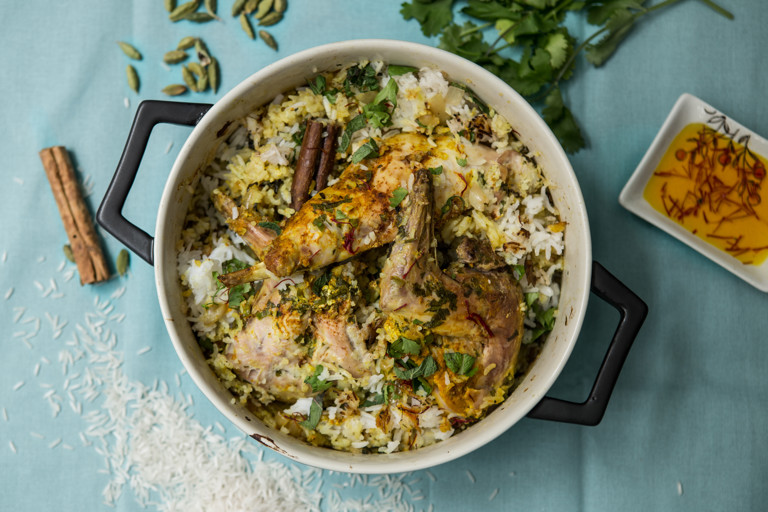Rabbit biryani
Have you ever cooked rabbit before? Some may turn up their nose or shudder at the thought of eating one. However, Shu Han believes it's time to look at rabbit without going doe-eyed and thinking of Watership Down. She argues that rabbit is one of the most sustainable, ethical, and wholesome things you could eat and also makes for a very tasty curry.
Before I start, I'm sorry, Rachel and Christine, two of my best bunny-loving friends. I should be sentenced to a diet of carrots for the rest of my life to make up for my sin, for laying my hands on these innocent, long-eared, wide-eyed creatures. But, let me try make a case for myself and all the generations of rabbit-eaters before me.
Wild rabbits are actually one of the most sustainable, ethical, and wholesome things you could eat. Put aside all thoughts of the Fluffy you cuddle at night. They are in fact farmers' pests, feeding enthusiastically on and damaging millions worth of crops. And the country is teeming with them. If you paid attention to Miss Chng in Biology class, you would have learnt that they breed with ferocious passion and gusto. Rabbit has been a British staple for centuries, especially during the World War, because it was cheap and plentiful, but it fell out of favour when people could better afford other sorts of meat, especially as factory-farmed beef and battery-caged chickens came into the picture. Horrible mass-produced meat aside, even the most humanely-reared, corn-fed, free-range chickens put an extra strain on the Earth's resources. The rabbit population, on the other hand, needs to be controlled to maintain the balance in nature.
To make you feel even better, their truly free-range lifestyle and wild diet mean that their meat is very lean, healthy and flavoursome. You can do your bit by plopping them into your pot of stew or curry, or in this case, making biryani out of them. I find chilli and spices a must when I cook game because I'm not the biggest fan of gamey smells (see chinese-style braised venison and pot-roasted pheasant with kimchi).
This biryani here is made in a very similar fashion to the Indian hyberbadi biryani, but is really more inspired by fond memories of the nasi biryani my mum would buy me when she picked me up from school. The 'nasi'here is a Malay word for rice, and 'biryani' an Indian word to explain the cooking process, another sign of the culinary mishmash of cultures in Singapore-- one that is described as mamak cuisine back home.
Biryani has a notorious reputation of being difficult to cook, but really, it's a very convenient one-pot dinner that will happily feed the masses, old and young. The ingredient list is long I admit, but once you have them, it's just a matter of bunging them all together. The most difficult bit is perhaps, convincing them to eat Bugs Bunny. I've tried my best, but if all that still doesn't convince, you could replace the rabbit here with lamb, or chicken, which is what it tastes like anyway, just with less fat and a stronger flavour. It's too yummy to pass up.
I know the ingredients list seems daunting, but there is not much actual work involved, and most of the time required is really just for the rabbit to sit, tenderise and absorb all the deliciousness from the marinade. And if you must grumble about that 15-20 minutes of active kitchen time, just think of the end results. Scrumptious rabbit, and of course, the real star of the show, the rice-- loose and flowing and filled with the perfume of spices and flavour from the meat (and bones).
Now if that whole paragraph above couldn't convince the bunny-eater in you, I hope this biryani does
Ingredients
Metric
Imperial
Biryani
- 1 rabbit, whole and wild, on the bone (about 800g)
- 630g of basmati rice, soaked for 30 minutes then drained
- 1 tbsp of sea salt
- 1 bay leaf
- 1 cinnamon stick
- 3 tbsp of ghee, melted
- 2 handfuls of onion, fried
- 25g of mint, and coriander, chopped
- 1 pinch of saffron, soaked in warm water or milk (this colours and flavours the rice golden. I don't like to use artificial colourings, so there's no jovial mix of fluorescent orange and yellow in my biryani)
For the marinade
- 245g of yoghurt
- 2 tbsp of ginger-garlic paste
- 1 cinnamon stick
- 2 cloves
- 10 cardamom pods
- 1 tbsp of red chilli powder
- 2 tsp turmeric
- 2 green chillies, finely chopped
- 25g of mint, and coriander, chopped
- 1 lemon, juiced
- 1 handful of onion, fried and crushed
- 2 tbsp of ghee, melted
- 1 tsp sea salt
Method
Get in touch
Please sign in or register to send a comment to Great British Chefs.


